Sashimi, a Japanese way of serving raw fish, is by now well known to diners around the world. Less familiar, however, are the garnishes that accompany the succulent slices. Are you meant to eat the piles of daikon strings that come with your raw fish? How about the seaweeds and flowers? And what are all the garnishes that accompany sashimi, anyway?
This article will identify the most common sashimi garnishes and explain why they are there. Are the garnishes just for decoration? Or do they serve another purpose? Read on to find out.
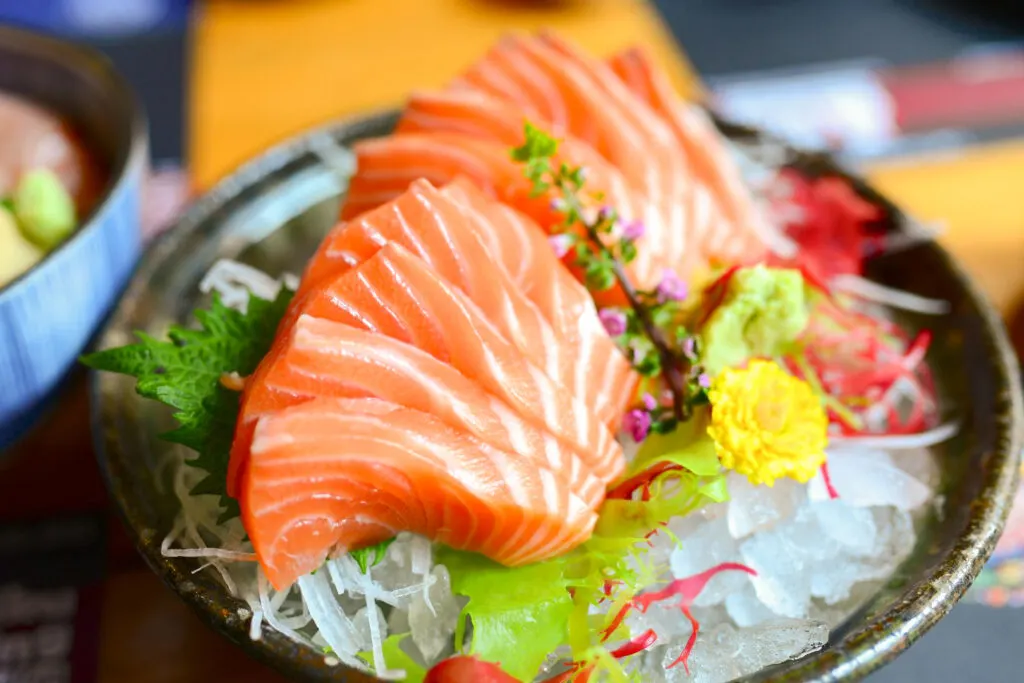
Table of Contents
Daikon strings are called ‘tsuma’
Let’s start with the heaps of white-radish strings that come under or around the slices of raw fish, probably the garnish most readers know best.
In Japan, this thinly sliced daikon is referred to by chefs as tsuma. Most Japanese could produce that term, if prompted, but they may not realize it is a generic label that can be applied to any of the embellishments on a serving of raw fish.
But hold on! If you’ve lived in Japan, you may know that tsuma is one way of saying “wife” in Japanese. Do the two words just happen to be homonyms? Or is there some deeper connection?
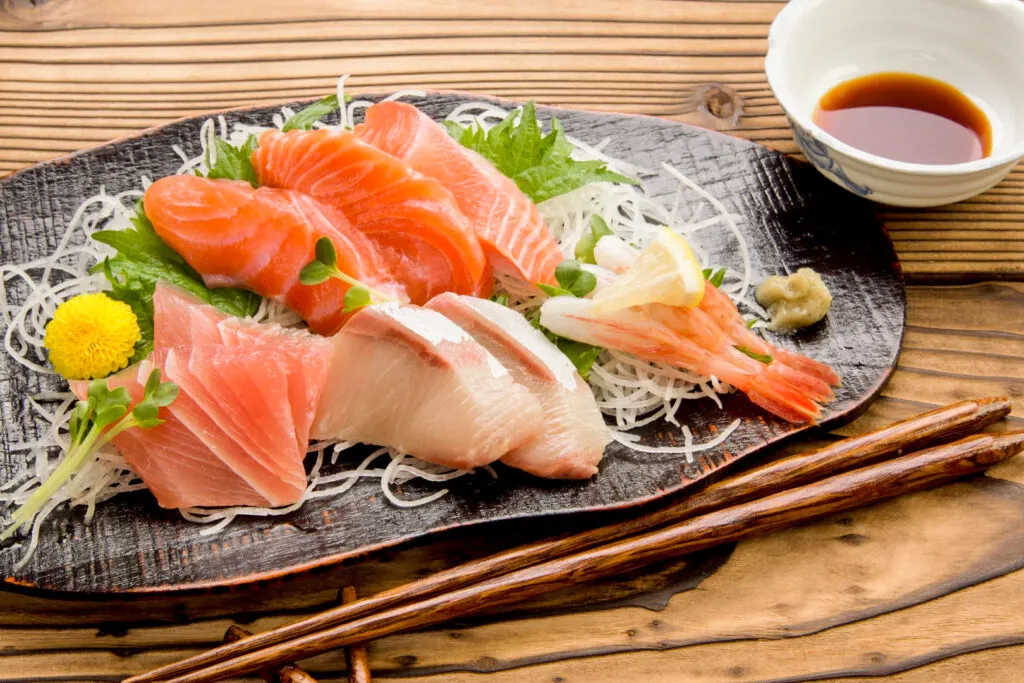
‘Wife of Sashimi?’ Really?
Many people assume, if only because the words sound the same, that the name tsuma for sashimi garnishes literally does mean “wife.” Like my friend Hiroshi, who once philosophized—over succulent slices of salmon and, admittedly, plenty of warm sake—that “a plate of raw fish is like a happy household, in which the sashimi [the ‘husband,’ as he explained it] exists in harmony with the supportive yet subordinate garnishes [the ‘wife’].”
Oh, but not so fast, a gentleman at the next table interjected, having overheard Hiroshi’s tipsy discourse. “Look at the kanji,” he urged, referring to the characters with which Japanese is written, and leaning over to show us his phone. “See? The words may sound the same, but they are written differently. And the difference is telling.”
This was true. The dictionary on his phone showed that the correct kanji for tsuma-meaning-garnishes is 褄. The right part of that character is indeed 妻, the kanji for tsuma-meaning-wife. But it is prefaced on the left by 衤, which is a building block (the koromo-hen radical) that signifies the character has something to do with clothing.
Our friendly informant pointed out that the more complicated of the two characters (褄) can also be used when writing about the lower front panel of a kimono, also read as “tsuma.” Thus, this kanji suggests something at the edge and the more learned explanation as to why sashimi garnishes are called tsuma is because the word means “something at the side.”
Sorry, Hiroshi.
Dissed and dismissed
If I may make one more —ahem —aside, there’s an interesting colloquialism related to all this. In casual Japanese, you occasionally hear someone use the phrase, “sashimi no tsuma” (刺身のツマ, “the garnish for sashimi”), meaning someone or something of little consequence.
A businessman, for example, might dismiss a colleague by saying —and this is a male-gendered way of speaking, which is why I say “businessman” — kono ken ni tsuite, kare wa sashimi no tsuma no yōna mono da. (“On this matter, he’s like the garnish for sashimi.”) It means the colleague’s input and opinion are unimportant, and there’s no reason to take either into account.
Raw fish hasn’t always come with garnishes
If you will allow me one final diversion, this time into history, it turns out that sashimi hasn’t always been eaten the way we eat it today. And as much as we associate sashimi and sushi with Japan, the custom of eating raw fish actually originated in China!
According to Ayao Okumura, a chef, food consultant and cookbook author who has studied how Japanese cooking developed, raw fish recipes were brought to Japan from China, perhaps as early as the Kamakura Period (1185-1333).
At that time, the Chinese ate carp and sea bass chopped raw into pieces and tossed with strongly flavored vegetables such as scallions and garlic. This was the way the Japanese initially consumed raw fish, too. Over time, the practice of eating raw fish died out in China but remained popular in Japan, albeit as a luxury enjoyed only by aristocrats.
Keeping it fresh, how sashimi garnishes came to be
One of the earliest cookbooks in Japan, written in 1489, includes instructions for preparing raw fish. The flesh should be carefully sliced, the recipe directs, then mixed with vinegar flavored with any number of possible variants. Options included salt, wasabi, ginger, and a peppery leaf called tade, which is a flowering plant in the buckwheat family.
In those days before refrigeration and modern distribution, these sorts of highly flavored and aromatic seasonings were added primarily to mask fishy tastes and smells. But they also slowed the rate of spoilage because, as we now know, many of these ingredients, and especially wasabi, contain natural anti-bacterial compounds.
The way we enjoy sashimi today — a presentation of plain slices of fish or shellfish that can be dipped in soy sauce or other sauces to taste — was a much later development. “That style of eating raw fish didn’t come about until late in the Edo Period [1603-1868],” Okumura told me. “Instead of mixing the sauces and vegetables into the fish, it became popular to offer sauces on the side in separate dishes. It was at that point that vegetables and other edibles began to be placed under or around the fish.”
To Eat or Not to Eat, That is the Question
This brings us to the question that probably brought you to this page: do you, or do you not, eat the sashimi garnishes? Believe it or not, this is a hot topic in Japan, too. It turns up regularly in online forums in Japanese, and every few years there’s a survey of consumer attitudes on exactly this that will be widely reported in the Japanese press. One of the largest I came across, conducted in 2015, collected answers from more than 12,000 men and women in Japan. So, what did they say?
Of the 12,000+ survey respondents, a small minority staunchly maintained that it is bad manners to down the decorations. Another vocal minority said they never consume the daikon or other garnishes because they worry it might be contaminated with blood from the fish. But fully 76 percent of respondents answered yes, they do eat the tsuma. I generally do, too. Nevertheless, I thought it best to make a final check with a true authority and put the question to Okumura.
“It’s fine to eat the tsuma,” he assured me. “You’ll get a little extra nutrition and you can enjoy the different flavors and textures.” Okumura did, however, offer one small caveat: he thinks it’s better to set aside the whole chrysanthemum flowers. “They aren’t toxic, or anything, but the centers are pretty bitter. That said, the petals are fine and are often used in fall dishes. But I think they are better when lightly boiled first.”
Bottom line? The decision to eat a sashimi garnish, or not eat it, is a personal one. If a garnish looks appetizing, go ahead and taste it. If you don’t like it, leave it alone the next time. No one is going to be shocked or offended either way. Even if you eat the mums.
Common Sashimi Garnishes Explained
Ok, now let’s —finally!— identify the most common garnishes. In addition to the near ubiquitous daikon, already discussed above, you have probably seen artfully carved carrot strips, tiny whole chrysanthemum flowers, and possibly red and green seaweeds.
These and other garnishes are commercially grown and distributed in Japan, and are often available in supermarkets, as well. What follows is a field guide to help you identify the garnishes that come with your raw fish, and whether or not you want to eat them.
Myōga
I’m particularly fond of this one which is the flower bud of the ginger plant. It has a crisp texture and unique taste, quite different from ginger root. (In case you’re wondering, this is nothing like the slices of pickled ginger, called gari, that usually is served with sushi.)
Myōga (茗荷, みょうが) is the classic accompaniment for a raw fish dish called katsuo tataki, in which a slab of skipjack tuna sashimi is lightly seared over an open fire and served in slices, with the insides still raw. The bold tang of myōga stands up well to this strongly flavored fish. I encourage you to try it.
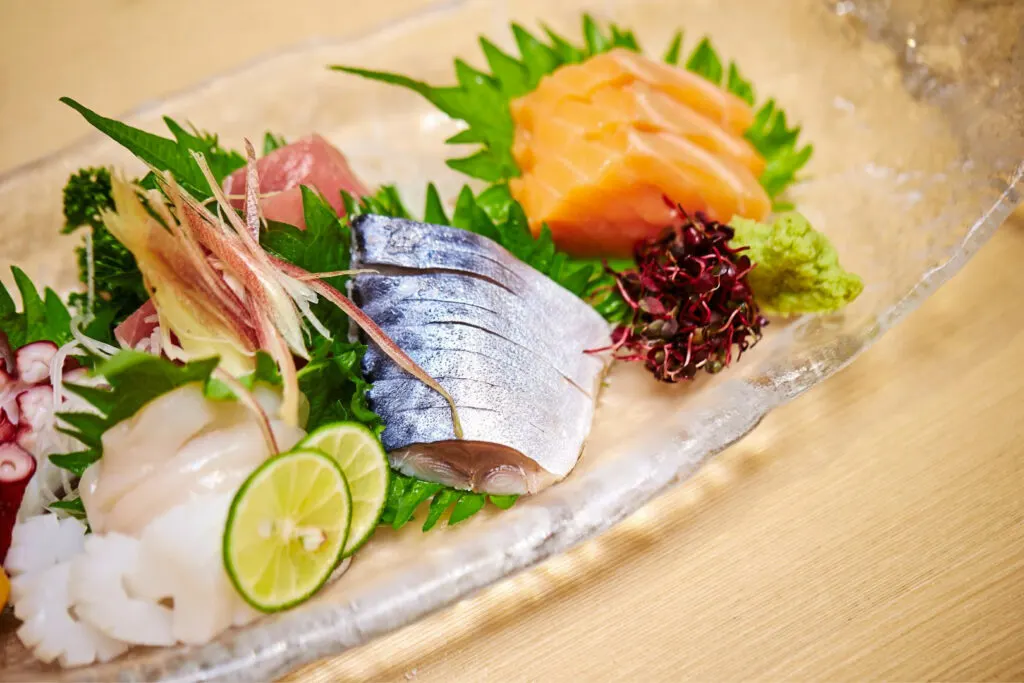
Shiso Leaves
Another garnish with a really distinctive flavor is shiso, the leaf of an unfussy green garden plant, Perilla frutescens. It is sometimes described in English as “beefsteak plant” but, thanks to the rising international popularity of Japanese ingredients, “shiso” now appears on menus outside of Japan and even in some dictionaries, signaling its official entry into the English language.
Shiso is perfectly fine to eat if the leaves still look fresh and appealing.
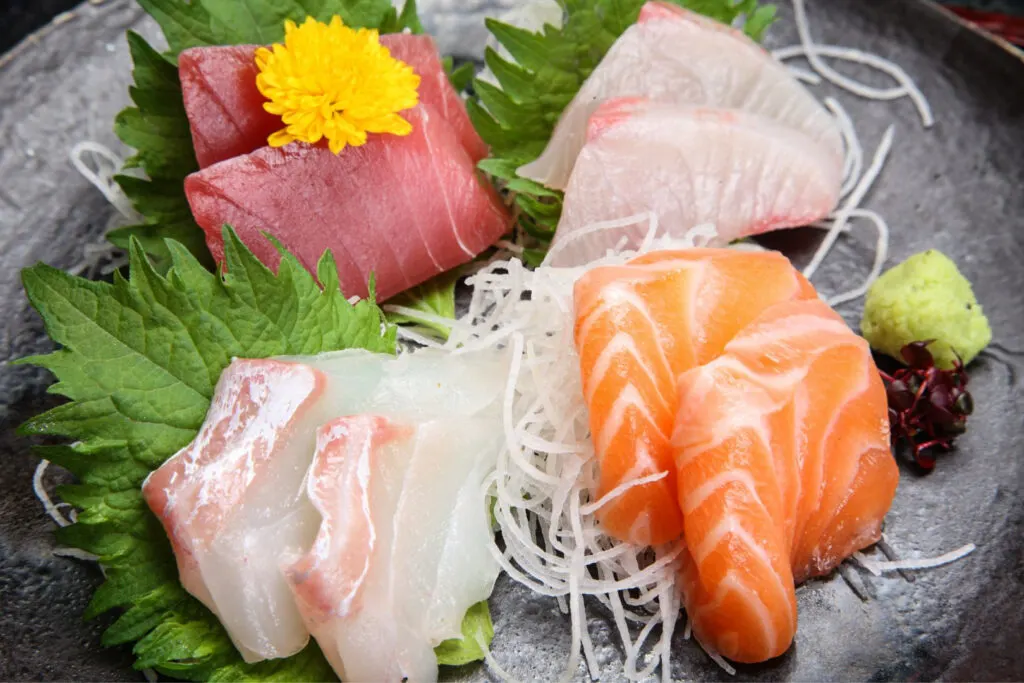
Green and Red Shiso Sprouts
There’s also a red version of the shiso plant, and the sprouts of both the red and green plants are known collectively as mejiso (芽じそ, shiso sprouts).
More specifically, the green version is aome (あおめ, green sprouts), while the red shiso sprouts, which are actually purple and green, are called murame (ムラメ, purple sprouts). But honestly, very few people know those names.
The sprouts are fine to eat, and people often move them into the soy sauce dish so they can scoop up the sprouts when dipping the fish slices in the soy sauce.
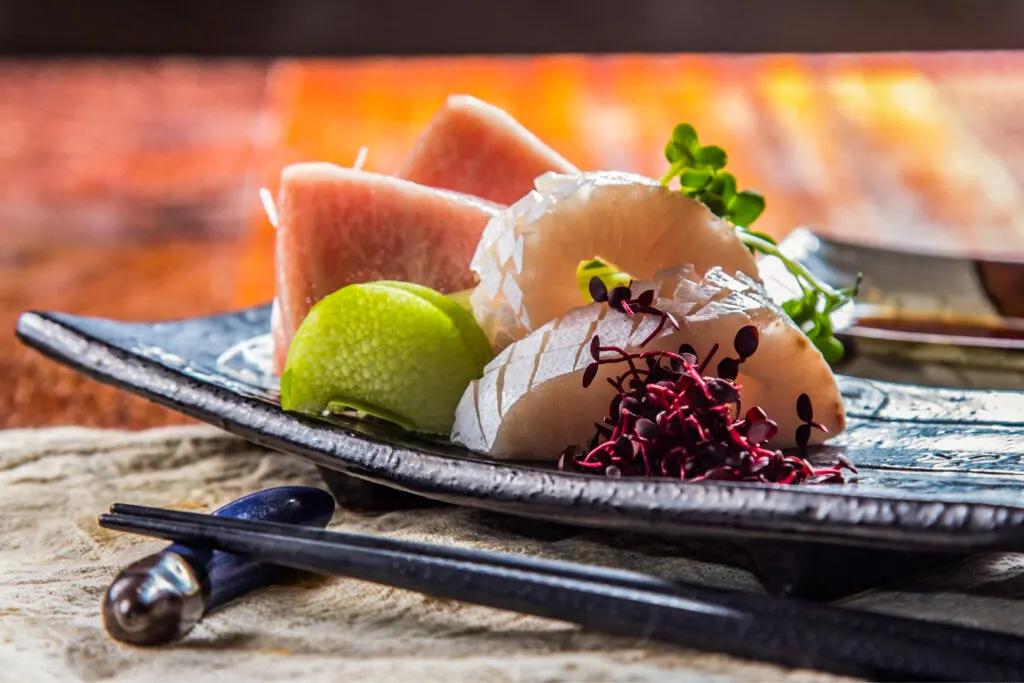
Green Seaweed #1 – Wakame
The most common green seaweed in sashimi presentations is wakame (ワカメ, Undaria pinnatifida), a kind of kelp. The leaves of the wakame plant are large and broad, so wakame is usually served cut into easy-to-eat pieces.
Wakame is plentiful in cooler waters all around Japan, and is rich in iodine and calcium. It’s also a good source of iron. If you like it, go ahead and eat the wakame that comes with your sashimi. It’s the same seaweed that commonly appears in miso soup. In fact, wakame is so common that the word has entered the English language.
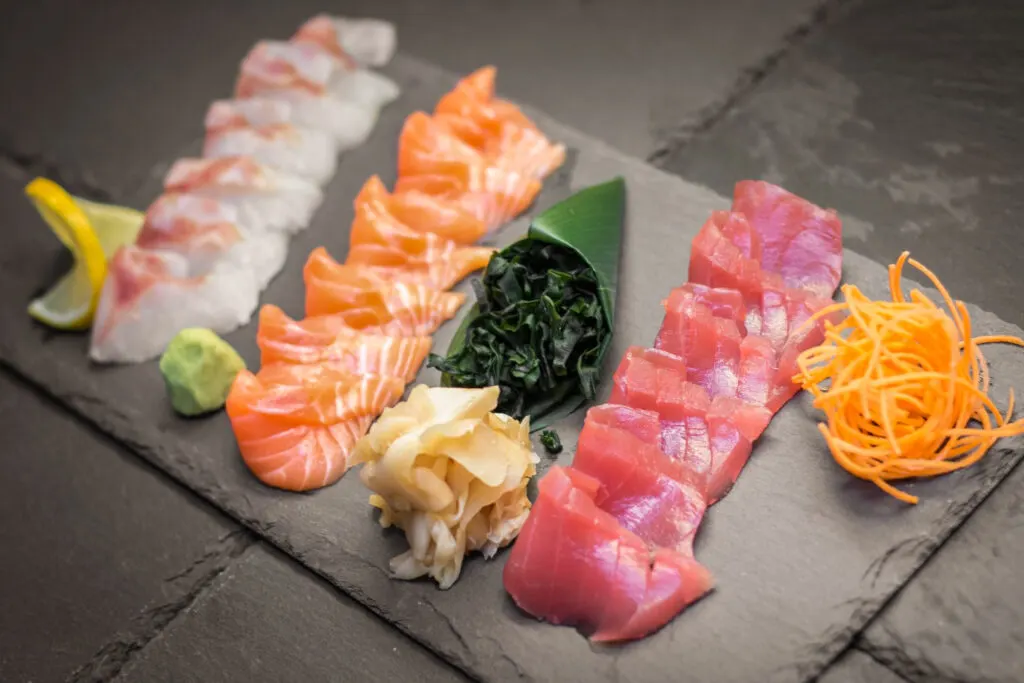
Green Seaweed #2 – Ogonori
If the green seaweed on your plate is stringy and coarse, it’s probably ogonori (オゴノリ, Gracilaria vermiculophylla), which is sometimes identified in English as “Chinese moss” or “false Ceylon moss.”
It’s actually a red algae that turns green when it’s boiled, and should not be eaten in its red state because it contains a toxin. In a much publicized case in 1993, a woman in Yokohama died when she ate ogonori she had collected herself and served raw.
The ogonori served in restaurants is of course properly processed —the green color is proof —but the poisoning story does give me pause. I tend to push this one aside but have eaten it without incident.
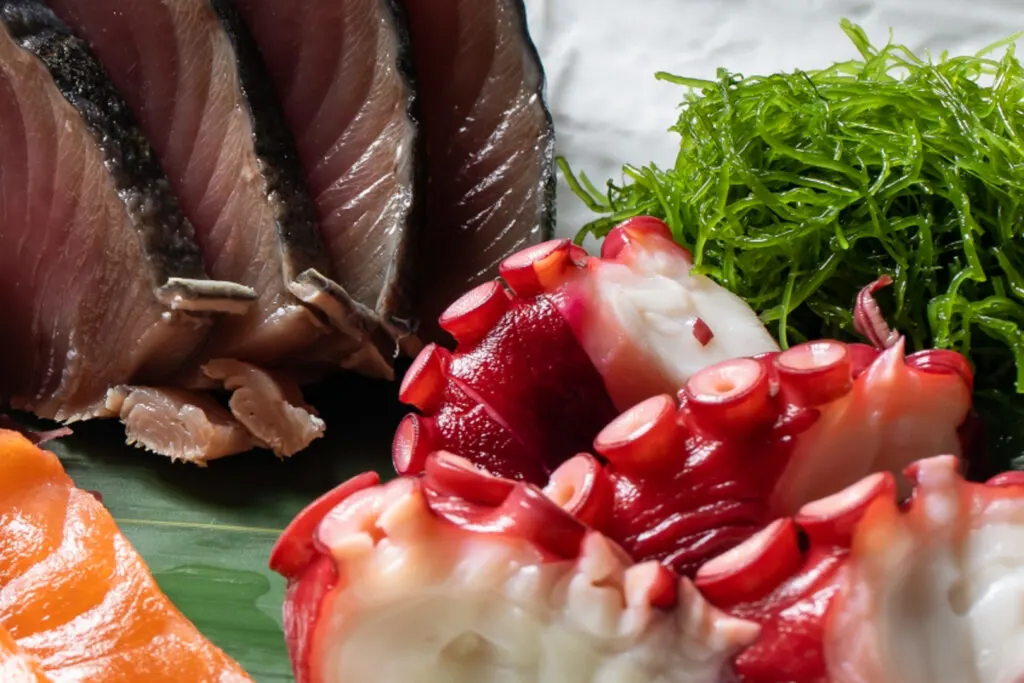
Red seaweed – Tosakanori
This one is called tosakanori (トサカノリ, Meristotheca papulosa) or just plain tosaka, which is the word for a rooster’s comb.
The seaweed, which is branched and spikey, does resemble the fleshy crest on a rooster’s head, and is a purplish red that adds nice color to sashimi presentations.
No problem eating this if you like it. It’s a good source of iodine and often turns up in mixed seaweed salad.
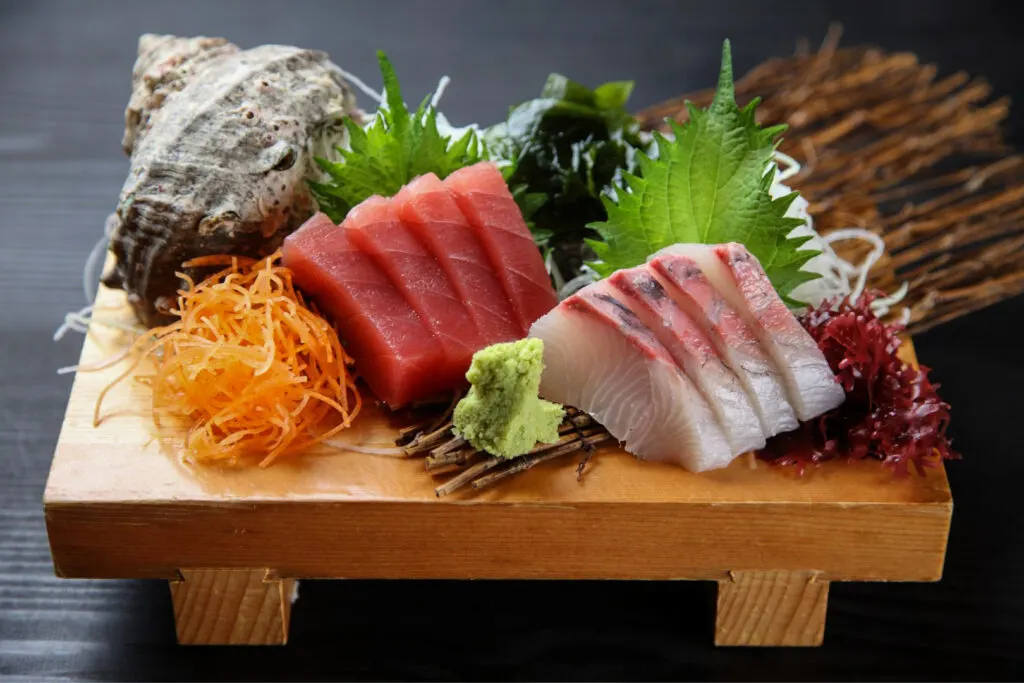
Flower #1 – Yellow petals and mini chrysanthemum blooms
Sometimes a presentation of sashimi is decorated with a few chrysanthemum petals, larger than the tiny ones that are part of the complete blossom. More often you’ll see an entire tiny bloom, neatly beheaded.
The whole flowers are fairly bitter, and so are best set aside. But don’t worry if you’ve already eaten one; it won’t hurt you. And no one cared or noticed.
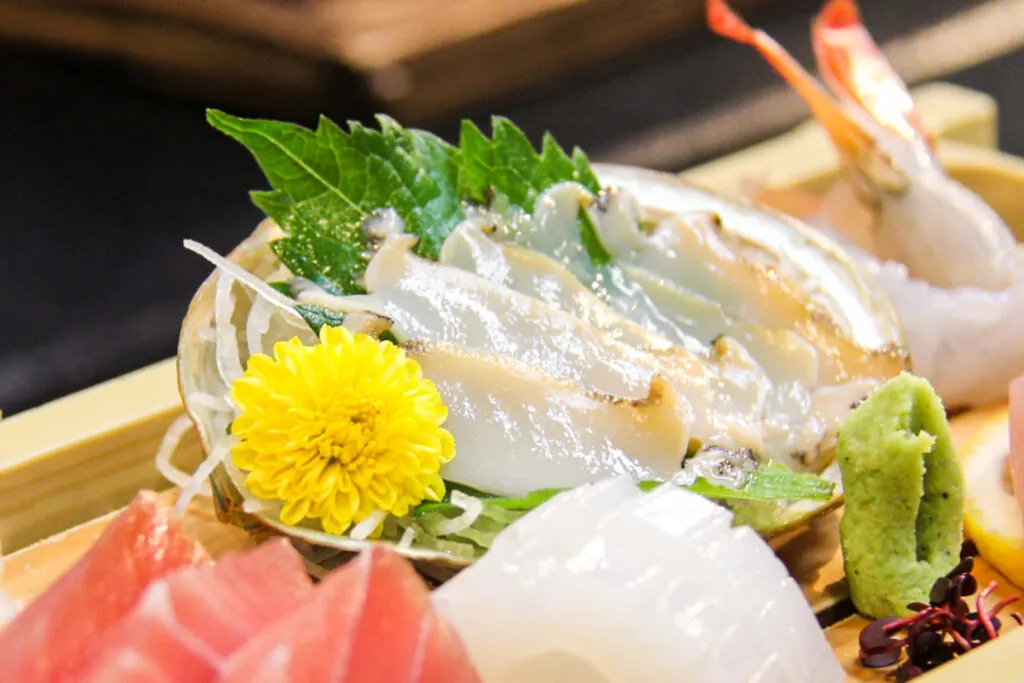
Flower #2 – Kasui
Another flower that turns up often, as tiny purple flower buds up and down a small piece of green stalk, is one more part of the shiso plant.
Called kasui (花穂 , meaning “flower spikes”) or kasui jiso 花穂じそ (shiso flower spikes), people tend to pull the buds off with their fingers or chopsticks and drop them into the soy sauce, leaving the tough stems aside.
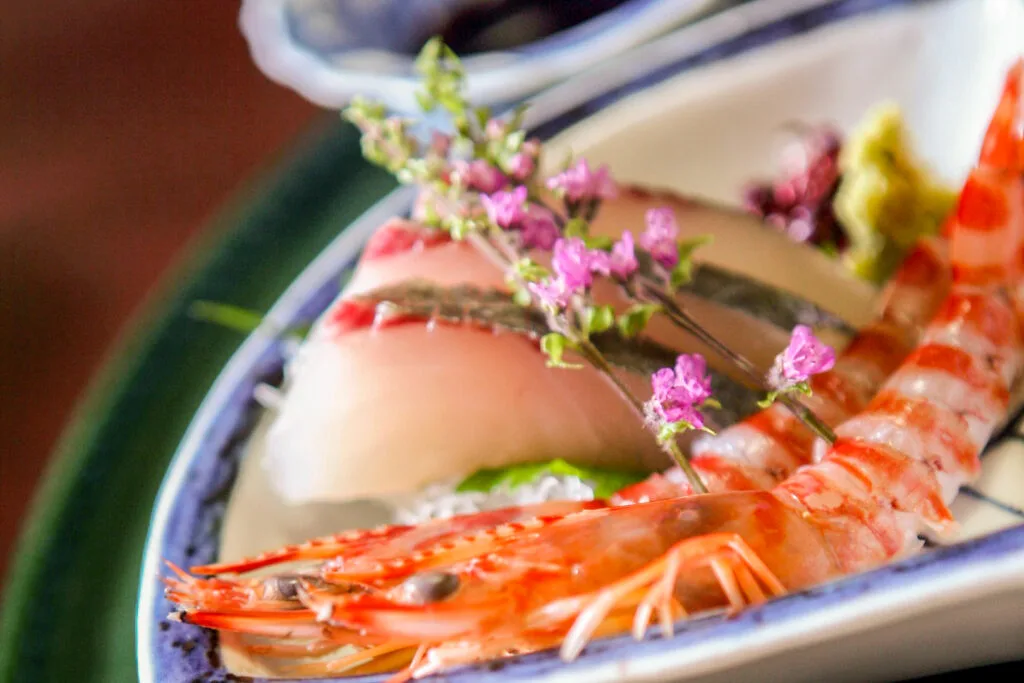
Bon appetit! Enjoy your sashimi!
Have you ever eaten your sashimi garnishes? Would you? Which ones?
Pin me for later
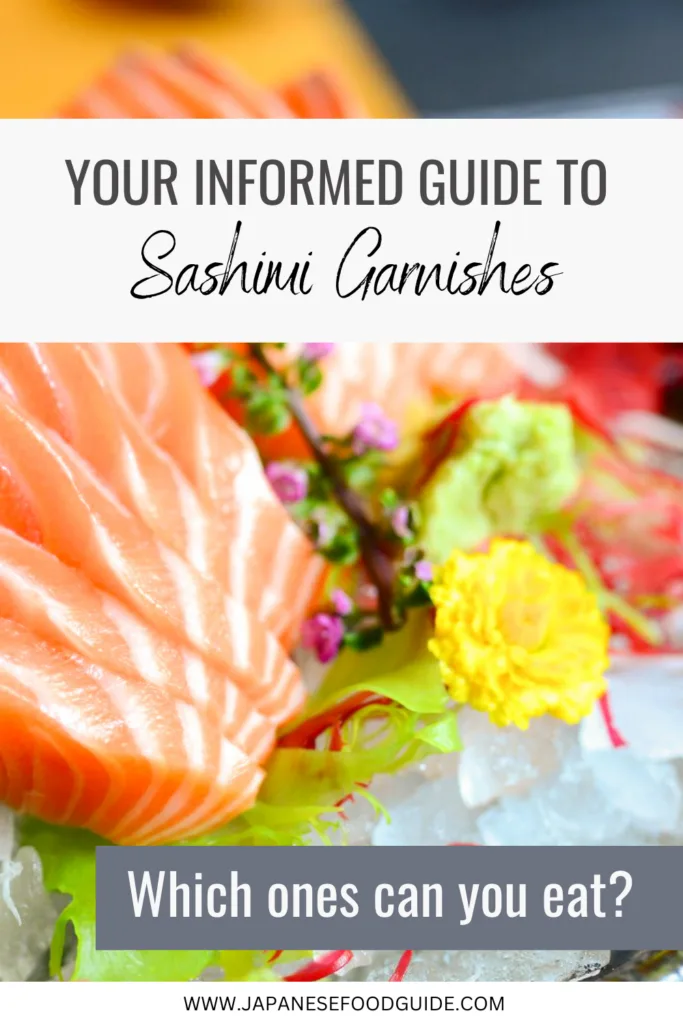
Alice Gordenker is a Tokyo-based writer. She started her career in journalism reporting from Washington, DC for food industry trade publications on regulation and legislation. Since relocating to Tokyo more than 20 years ago, Alice has made it her “life work” to provide insight on Japan through various media including newspapers, magazines, television and film.
She is delighted to be an early contributor to Japanese Food Guide, where she can once again focus on great things to eat, and how they are grown or made.
